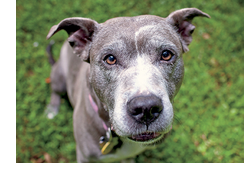
Cognitive Dysfunction Syndrome (CDS) is a newly recognised disease, somewhat similar to Alzheimer’s disease in people. In dogs with Cognitive Dysfunction Syndrome, the brain undergoes a series of changes that result in a decline in the mental faculties associated with thinking, recognition, memory, and learned behaviour.
FACT: Fifty percent of dogs over age 10 will exhibit one or more symptoms of cognitive dysfunction syndrome. It is a progressive disease, meaning signs will get worse over time.
SIGNS
Disorientation – If your dog appears lost in the house or yard, gets stuck in corners or under or behind furniture, has difficulty finding the door (stands at the hinge side or goes to the wrong door), doesn’t recognise familiar people, and fails to respond to verbal cues or his name.
Activity and sleep patterns are disturbed – If your dog sleeps more in a 24-hour period, but sleeps less during the night. There is a decrease in purposeful activity and an increase in aimless wandering and pacing, circling, tremors, stiffness, and weakness.
Housetraining – If your dog may urinate and/or defecate indoors, sometimes even in the view of his owners, and may signal less often to go outside.
Changes to interactions with family members – Often, interactions with family members become much less intense. The dog seeks less attention, often walks away when being patted, shows less enthusiasm when greeted, and may no longer greet his family.
If you notice behavioural changes in your pet, visit a vet as soon as possible. Other conditions can also be the cause of these symptoms and it is important that your pet is looked over and/or tested to rule them out.
CAUSES
Research on the aging canine brain reveals a number of pathogenic processes that could account for many of the symptoms of cognitive dysfunction syndrome.
1. A protein called β-amyloid is deposited in the white and grey matter of the brain. Plaques from that result in cell death and brain shrinkage.
2. Alterations in various neurotransmitter chemicals, including serotonin, norepinephrine, and dopamine, have been described.
3. Oxygen levels in the brains of senile dogs are decreased.
DIAGNOSIS
There is no specific test for cognitive dysfunction syndrome. The number of symptoms the dog exhibits and the severity of the senile behaviour are important considerations in making the diagnosis. An MRI may show some degree of brain shrinkage, but the test is not likely to be done unless a brain tumour is suspected. Awareness of the diagnosis makes it easier to understand the dog’s behaviour.
TREATMENT
Because the underlying cause can vary between patients there is no one treatment. A number of treatments have been found to be beneficial, including the use of medications, nutritional supplements, daily exercise and sensory stimulation such as touching, massaging and brushing.
Did you know that your pet is considered a senior from the age of 7 years? Pet Doctors Palm Beach have a specialised Seniors Wellness Plan designed specifically for older pets to maintain and monitor prevalent diseases.


